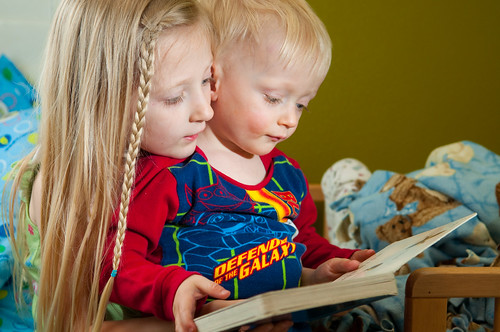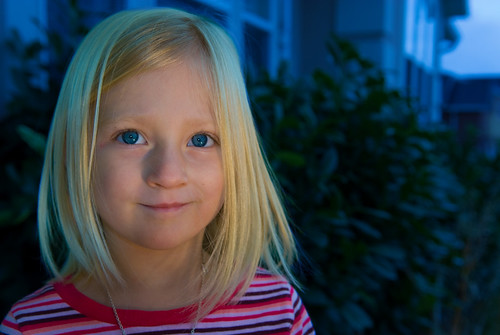The bigger the aperture (the lower the f-stop number: like 3.5 or 2.8 or even 1.4) the more light we let in. So we are able to use the available light. In addition, we can increase the ISO to around 800 to 1250 (or even to 1600)
Camera set on A (aperture priority) So with these 2 preparations, we are ready to capture some images. Wait, we need a setting and a subject. So, I took my kids... naturally. I put them in a reflected light. The sun was coming through the window and bouncing off of our white fridge. It was actually a little hot (too bright) but it worked. At first, my images were too bright because my light meter was set on "spot metering". Because the center of the image was darker, it overexposed the reflected light. To fix that, simply put the metering to "matrix metering" and it should compensate for that light.
Place the subject out of the direct light coming in, or you will get hot spots like this image...
| From 20101212 |
Move the subject so that the back of their head is in the direct light and it looks like this...
 |
| From 20101212 |
Move them out of the direct light all together...
 |
| From 20101212 |
And finally, one more...
 |
| From 20101212 |
So, the pick of the day will be a different setting. Subject with one light coming through the window. Window at 2 o-clock and photographer at 6 o-clock.
 |
| From 20101212 |
























 I am shooting these at about F4 and between 1/30 and 1/80 of a second with ISO between 100 and 200 in full Manual mode. I find that I generally get better results with 2 or 3 flashes when I go manual on cameras and manual power on the flashes.
I am shooting these at about F4 and between 1/30 and 1/80 of a second with ISO between 100 and 200 in full Manual mode. I find that I generally get better results with 2 or 3 flashes when I go manual on cameras and manual power on the flashes. 
 I like not having a shadow behind the subject... to avoid this, increase the intensity of the reflected light (or ambient light with the shutter time being longer) and don't place an object close behind the subject (in the plane of the snoot and subject -hope that made sense
I like not having a shadow behind the subject... to avoid this, increase the intensity of the reflected light (or ambient light with the shutter time being longer) and don't place an object close behind the subject (in the plane of the snoot and subject -hope that made sense
















